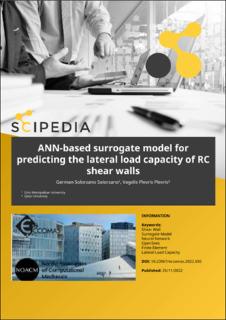| dc.contributor.author | Solorzano, German | |
| dc.contributor.author | Plevris, Vagelis | |
| dc.date.accessioned | 2023-02-17T13:57:00Z | |
| dc.date.available | 2023-02-17T13:57:00Z | |
| dc.date.created | 2023-02-09T18:55:09Z | |
| dc.date.issued | 2022 | |
| dc.identifier.isbn | 9788412322286 | |
| dc.identifier.uri | https://hdl.handle.net/11250/3052020 | |
| dc.description.abstract | Reinforced concrete (RC) shear walls are often used as the main lateral-resisting component in the seismic design of buildings. They provide a large percentage of the lateral stiffness of the structure, and therefore, they may experience large shear stresses at some point under earthquake loading. Consequentially, to accurately predict their behavior, it is recommended to use detailed finite element (FE) modeling with appropriate non-linear constitutive models for concrete and steel. However, such types of simulations are challenging and could significantly increase the computational time required to obtain the analysis results. In this paper, we study the viability of creating an artificial neural-network-based surrogate model of the RC shear wall that is able to capture its nonlinear behavior and predict the results obtained with a detailed FE model, offering a much lower computational effort. For this purpose, we develop a detailed parametric non-linear FE model based on well-established practices and validated studies using the OpenSees finite element software framework. The FE model consists of multi-layer shell elements with the vertical and transverse reinforcement included as smeared rebar layers. The concrete layers implement a damage mechanism with smeared crack constitutive model, whereas the rebar layers consider a uniaxial plasticity material law. The parametric FE model is used to build a large database of RC walls of different sizes and characteristics, with their corresponding lateral load capacity that is obtained through the detailed non-linear pushover analysis. Finally, the obtained database is used to train and validate the ANN-surrogate model. The developed model is able to accurately predict the lateral load capacity of RC shear walls without the need of detailed FE modeling, thus drastically reducing the complexity and the computational time required for the numerical solution and providing a reliable and robust analysis alternative, with only small compromise of accuracy. | en_US |
| dc.language.iso | eng | en_US |
| dc.publisher | ECCOMAS | en_US |
| dc.relation.ispartof | 8th European Congress on Computational Methods in Applied Sciences and Engineering (ECCOMAS Congress 2022) | |
| dc.relation.ispartofseries | ECCOMAS Congress;8th European Congress on Computational Methods in Applied Sciences and Engineering | |
| dc.rights | Navngivelse-Ikkekommersiell-DelPåSammeVilkår 4.0 Internasjonal | * |
| dc.rights.uri | http://creativecommons.org/licenses/by-nc-sa/4.0/deed.no | * |
| dc.title | ANN-based surrogate model for predicting the lateral load capacity of RC shear walls | en_US |
| dc.type | Conference object | en_US |
| dc.description.version | publishedVersion | en_US |
| cristin.ispublished | true | |
| cristin.fulltext | original | |
| cristin.qualitycode | 1 | |
| dc.identifier.doi | https://doi.org/10.23967/eccomas.2022.050 | |
| dc.identifier.cristin | 2124696 | |
| dc.source.volume | 8 | en_US |
| dc.source.issue | 8 | en_US |
| dc.source.pagenumber | 1-18 | en_US |

